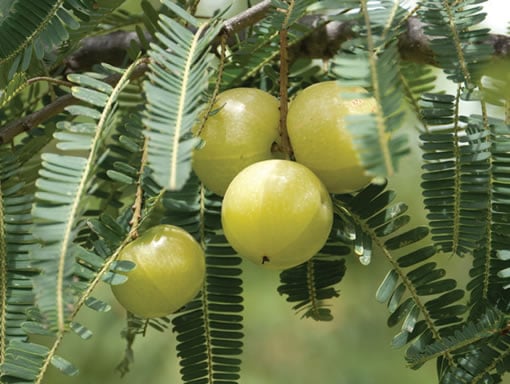Amla

Amla (Phyllanthus emblica) or Indian gooseberry, is one of the most important herbs in Ayurveda's pharmacopoeia. Amla is one of the major ingredients in two of the most famous Ayurvedic preparations; triphala and chywanaprash (Pukka Golden Preserve). Triphala is a traditional tonic for the whole digestive system, nourishing and strengthening it from the inside out. Golden Preserve is a traditional Ayurvedic elixir tonic jam that is a superb rejuvenative for the immune system, in particular the lungs, all three Ayurvedic doshas and the reproductive system. The fruit is extremely sour when you bite into it, but after a few minutes it leaves you with a surprisingly sweet aftertaste. This 'post digestive' taste is referred to as vipaka in Ayurveda and is a special insight of Ayurvedic genius. The sweet after-effect indicates its potent rejuvenative properties. Amla can be literally translated to mean 'sour'.
Amla is particularly effective for reducing inflammation in the digestive tract, acts as a mild laxative and also strengthens the heart. Amla berries are incredibly powerful antioxidants with high levels of naturally occurring bioflavonoids and Vitamin C that make this herb very protective for the heart and blood vessels as well as the immune system. Amla is considered to be an immunostimulant, enhancing overall immunity and supporting the non-specific immune response. In Ayurveda, amla is also revered as a hepatoprotective agent that protects against chemical induced carcinogenesis and oxidative stress. The stabilising and protective nature of this particular herb indicates its use to help prevent and treat any damage associated with connective tissue disorders, free radical exposure and also autoimmune based conditions.
The plant
Amla is a small to medium sized tree that grows throughout the Indian subcontinent. Commonly known as ‘Indian Gooseberry’, it has marble-sized green fruits, which are slightly larger but rounder and less hairy than their European cousins.
The fruits are traditionally collected from trees in the wild. In recent decades, with demand outstripping available supply, efforts have been made to bring it under cultivation and, now, large-fruited hybridised types are grown on a large scale in many parts of the country.
Pukka use a combination of wild collected and cultivated amla from the state of Karnataka in southern India and Rajasthan in the north. In many cases the fruit comes from wild trees growing on the borders of fields and in hedgerows on organic farms, just as Pukka may expect to find hawthorn growing on farms in the UK.
Harvesting and processing
The fruits are normally harvested when the first few fruits have started naturally falling from the tree. The most common method is for someone to shake the branches or to beat them with a stick whilst four others hold out a large sheet or tarpaulin to catch the falling fruit. If the tree is too big to shake or reach, the collector may climb the tree with a sack.
Amla is a surprisingly hard fruit, which makes it difficult to remove the large seed from its centre. The majority of amla processors boil or blanch the fruit to soften it, which makes it easier to split open but reduces its medicinal value and creates dark coloured segments when dried. To retain all the fruit’s original properties Pukka prefer to separate the stone by grating away the fresh fruit from around it. The freshly grated amla is then dried to produce beautiful golden coloured flakes.

Organic pioneers
Pukka have met many organic farmers who supply us with amla fruits, but one in particular stands out. Mahesh Gowda was the first farmer in his village to embrace organic farming, and focused on growing low-input crops, including amla trees, that are naturally resistant to pests and diseases. As with so many organic pioneers, he was ridiculed by neighbouring farmers, who told him that he would face heavy losses.
In 2010 Mahesh teamed up with Pukka's partners in Bangalore, who helped him with the costs and paperwork of organic certification and started buying his produce at a premium price. One by one his neighbours changed their tune and started taking an interest in organic farming. Now there are several farmers certified organic and many more in conversion – one of many examples of how a single organic pioneer can ignite a mini-revolution in his or her community.
Interesting facts
The Indian gooseberry has a number of different names: while 'amla' is the original Hindi name, you'll also find it described as 'amalaki' in Sanskrit and 'dhatri' in Ayurveda. With 'dhatri' meaning 'mother' or 'nurse', it's those nurturing properties that make it such an important part of many of Pukka's supplements.
A little bit of chemistry...
One of the primary constituents found in this fruit is naturally occurring ascorbic acid, more commonly known as Vitamin C. Vitamin C is an important co-factor in numerous enzymatic processes in the body including blood vessel formation, wound healing mechanisms, iron absorption and energy transfer. It is also a crucial component in protecting cellular membranes and, of course, the immune system, through its antioxidant capacities.
Amla is also high in protective bioflavonoids such as gallic acid, ellagic acid and rutin which are effective antioxidants, providing a deep level of cellular protection. They have been shown to offer cell regulating effects by correcting mutagenic behaviour offering chemoprotective effects. Ellagic acid specifically, has been noted to protect normal cells from radiation damage. Overall, these compounds have broad anti-inflammatory benefits that have the ability to stabilise connective tissue, blood vessels, bones, hair and the eyes.

